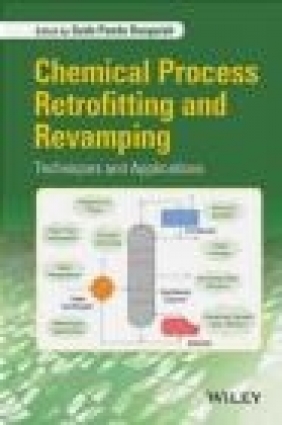Chemical Process Retrofitting and Revamping
Gade Pandu Rangaiah
Chemical Process Retrofitting and Revamping
Gade Pandu Rangaiah
- Wydawnictwo: John Wiley
- Rok wydania: 2016
- ISBN: 9781119016335
- Ilość stron: 432
- Oprawa: Twarda
Niedostępna
Opis: Chemical Process Retrofitting and Revamping - Gade Pandu Rangaiah
The proposed book will be divided into three parts. The chapters in Part I provide an overview of certain aspect of process retrofitting. The focus of Part II is on computational techniques for solving process retrofit problems. Finally, Part III addresses retrofit applications from diverse process industries. Some chapters in the book are contributed by practitioners whereas others are from academia. Hence, the book includes both new developments from research and also practical considerations. Many chapters include examples with realistic data. All these feature make the book useful to industrial engineers, researchers and students.List of Contributors xiii Preface xv PART I OVERVIEW 1 Introduction 3 G.P. Rangaiah 1.1 Chemical Process Plants 3 1.2 Process Retrofitting and Revamping 4 1.3 Stages in Process Retrofitting/Revamping Projects 6 1.4 Conceptual Process Design for Process Retrofit/Revamp Projects 8 1.5 Research and Development in Process Retrofit/Revamp 9 1.6 Scope and Organization of this Book 12 1.7 Conclusions 16 References 17 2 Project Engineering and Management for Process Retrofitting and Revamping 19 C.C.S. Reddy 2.1 Introduction 19 2.2 Key Differences between Revamp and Grassroots Designs 20 2.3 Revamp Design Methodology 20 2.4 Project/Process Engineering and Management of Revamp Projects 24 2.4.1 Revamp Objectives and Pre-Feasibility Study 24 2.4.2 Conceptual Design (Pre-FEED) 24 2.4.3 FEED (Front End Engineering Design) 31 2.4.4 Detailed Engineering, Procurement and Construction 33 2.4.5 Project Completion 35 2.5 Key Elements of Project Management 35 2.5.1 Project Schedule 39 2.5.2 Project Execution and Progress Monitoring 39 2.5.3 Project Cost Control 40 2.5.4 Risk Management 41 2.5.5 Final Project Deliverables 41 2.6 Revamp Options for Process Equipment 41 2.7 Conclusions 53 Acronyms 53 References 54 3 Process Safety in Revamp Projects 57 Raman Balajee and C.C.S. Reddy 3.1 Introduction 57 3.2 Lessons from Past Process Safety Incidents 59 3.3 Preliminary Hazard Review during Conceptual Design 60 3.3.1 Risk Matrix for Qualitative Judgments 61 3.3.2 What-If and Process Safety Check Lists 62 3.3.3 Plot Plan and Layout Review 63 3.3.4 Area Classification Reviews 65 3.3.5 Pressure Relief System Considerations 66 3.3.6 Fire Safety for Revamp Projects 72 3.4 Process Hazard Analysis (PHA) 74 3.4.1 Process Plant Hazard Review using HAZOP 74 3.4.2 Failure Modes and Effects Analysis (FMEA) Tool 79 3.4.3 Instrumented Protective System Design 81 3.4.4 Fault Tree Analysis 82 3.4.5 Event Tree Analysis 84 3.4.6 Layer of Protection Analysis (LOPA) 85 3.4.7 Safety Instrumented System (SIS) Life Cycle 88 3.5 Revision of PSI and Operator Induction 88 3.6 Pre-Start-up Safety Review (PSSR) 90 3.7 Management of Change (MOC) 91 3.8 Conclusions 92 Acronyms 93 Exercises 94 References 95 PART II TECHNIQUES FOR RETROFITTING AND REVAMPING 4 Mathematical Modeling, Simulation and Optimization for Process Design 99 Shivom Sharma and G.P. Rangaiah 4.1 Introduction 99 4.2 Process Modeling and Model Solution 101 4.2.1 Process Modeling 101 4.2.2 Model Solution 103 4.2.3 Model for Membrane Separation of a Gas Mixture 104 4.3 Process Simulators and Aspen Custom Modeler 107 4.4 Optimization Methods and Programs 108 4.5 Interfacing a Process Simulator with Excel 112 4.6 Application to Membrane Separation Process 113 4.7 Conclusions 116 Acronyms 116 Appendix 4A: Implementation of Membrane Model in ACM 117 Appendix 4B: Interfacing of Aspen Plus v8.4 with Excel 2013 119 Appendix 4C: Interfacing of Aspen HYSYS v8.4 with Excel 2013 122 Exercises 125 References 125 5 Process Intensification in Process Retrofitting and Revamping 129 D.P. Rao 5.1 Introduction 129 5.1.1 Retrofitting and Revamping 129 5.1.2 Evolution of Chemical Industries and Process Intensification 130 5.1.3 Flow Chemistry 130 5.2 Methods of Process Intensification 130 5.2.1 Intensification of Rates 131 5.2.2 Process Integration 132 5.3 Alternatives to Conventional Separators 132 5.3.1 Rotating Packed Beds (HIGEE) 133 5.3.2 HIGEE with Split Packing 134 5.3.3 Zigzag HIGEE 135 5.3.4 Multi-rotor Zigzag HIGEE 136 5.3.5 Applications of HIGEE for Retrofitting 137 5.3.6 Podbielniak Centrifugal Extractor 138 5.3.7 Annular Centrifugal Extractor 139 5.3.8 Adsorbers 140 5.4 Alternatives to Stirred Tank Reactor (STR) 142 5.4.1 HEX Reactor 142 5.4.2 Advanced-flowTM Reactor (AFR) 143 5.4.3 Agitated Cell Reactor (ACR) 145 5.4.4 Oscillatory-flow Baffled Reactors (OBR) 146 5.4.5 Spinning Disc Reactor (SDR) 147 5.4.6 Spinning Tube-in-tube Reactor (STTR) 148 5.4.7 Stator-rotor Spinning Disc Reactor (Stator-rotor SDR) 150 5.4.8 Reactor Selection 150 5.4.9 Microchannel Devices 151 5.5 Process Integration 151 5.5.1 Heat and Mass Integration 152 5.5.2 Reactive Separations 152 5.5.3 Hybrid Separation 153 5.5.4 Conversion of Crosscurrent into Countercurrent Process 153 5.5.5 Process-specific Integration 154 5.5.6 In-line Processing 157 5.5.7 Twister(R) - A Supersonic Separator 158 5.6 Fundamental Issues of PI 159 5.7 Future of PI 159 5.8 Conclusions 160 Acknowledgement 160 Appendix 5A: Monographs, Reviews and Some Recent Papers 160 References 163 6 Using Process Integration Technology to Retrofit Chemical Plants for Energy Conservation and Wastewater Minimization 167 Russell F. Dunn and Jarrid Scott Ristau 6.1 Introduction 167 6.1.1 Heat Integration Networks 168 6.1.2 Water Recycle Networks 169 6.2 Graphical Design Tools for Retrofitting Process for Energy Conservation by Designing Heat Exchange Networks 170 6.2.1 The Temperature Interval Diagram (TID) 171 6.2.2 The Heat Pinch Composite Curves (Temperature Enthalpy Diagrams) 172 6.2.3 The Enthalpy-Mapping Diagram (EMD) 174 6.2.4 Identifying Heat Integration Matches Using the TID and EMD 174 6.2.5 Graphical Tools Facilitate HEN Design for Large-scale Industrial Problems 177 6.3 Graphical Design Tools for Retrofitting Processes for Wastewater Reduction by Designing Water Recycle Networks 179 6.3.1 The Material Recycle Pinch Diagram 179 6.3.2 The Source Sink Mapping Diagram 181 6.3.3 Suggested Guidelines for Identifying Water Recycle Matches Using the Material Recycle Pinch Diagram and Source Sink Mapping Diagrams 181 6.4 Conclusions 182 Appendix 6A: Illustrating the Water Recycle Network Design Guidelines 183 Exercises 188 References 190 7 Heat Exchanger Network Retrofitting: Alternative Solutions via Multi-objective Optimization for Industrial Implementation 193 B.K. Sreepathi and G.P. Rangaiah 7.1 Introduction 193 7.2 Heat Exchanger Networks 196 7.2.1 Structural Representation 198 7.3 HEN Improvements 199 7.4 MOO Method, HEN Model and Exchanger Reassignment Strategy 203 7.4.1 Multi-objective Optimization 203 7.4.2 HEN Model 205 7.4.3 Exchanger Reassignment Strategy (ERS) 206 7.5 Case Study 208 7.6 Results and Discussion 208 7.6.1 Simple Retrofitting 209 7.6.2 Moderate Retrofitting 211 7.6.3 Complex Retrofitting 214 7.6.4 Comparison and Discussion 216 7.7 Conclusions 218 Appendix 7A: Calculation of Nodal Temperatures 218 Exercises 221 References 221 8 Review of Optimization Techniques for Retrofitting Batch Plants 223 Catherine Azzaro-Pantel 8.1 Introduction 223 8.2 Batch Plant Typical Features 224 8.3 Formulation of the Batch Plant Retrofit Problem 228 8.3.1 Design versus Retrofitting Problem 228 8.3.2 Design/Retrofit Problems: A Four-Level Framework 229 8.4 Methods and Tools for Retrofit Strategies 230 8.4.1 General Comments 230 8.4.2 Key Approaches in Batch Plant Retrofitting: Deterministic vs Stochastic Methods 238 8.4.3 New Trends in Batch Plant Retrofitting: Steps for More Sustainable Processes 242 8.5 Conclusions 243 References 244 PART III RETROFITTING AND REVAMPING APPLICATIONS 9 Retrofit of Side Stream Columns to Dividing Wall Columns, with Case Studies of Industrial Applications 251 Moonyong Lee, Le Quang Minh, Nguyen Van Duc Long, and Joonho Shin 9.1 Introduction 251 9.2 Side Stream Column 254 9.2.1 Side Stream Configuration 254 9.2.2 Heuristic Rules for the Use of SSCs 256 9.2.3 Pros and Cons of SSC 257 9.2.4 Design of SSC 257 9.3 Dividing Wall Column 258 9.3.1 Introduction 258 9.3.2 Design and Optimization of DWC 259 9.4 Retrofit of an SSC to a DWC 260 9.4.1 Introduction 260 9.4.2 Design and Optimization of Retrofitted DWC 260 9.4.3 Column Modification and Hardware 263 9.5 Case Studies of Industrial Applications 266 9.5.1 Acetic Acid Purification Column 266 9.5.2 n-BuOH Refining Column 271 9.6 Other Case Studies 275 9.6.1 Ethylene Dichloride (EDC) Purification Column 275 9.6.2 Diphenyl Carbonate (DPC) Purification Column 276 9.6.3 Other SSCs 277 9.7 Conclusions 277 Acknowledgements 278 Nomenclature 278 References 279 10 Techno-economic Evaluation of Membrane Separation for Retrofitting Olefin/Paraffin Fractionators in an Ethylene Plant 285 X.Z. Tan, S. Pandey, G.P. Rangaiah, and W. Niu 10.1 Introduction 285 10.2 Olefin/Paraffin Separation in an Ethylene Plant 287 10.3 Membrane Model Development 289 10.3.1 Membrane Modeling 289 10.3.2 Assumptions for Membrane Separation Simulation 291 10.4 Retrofitting a Distillation Column with a Membrane Unit 292 10.4.1 HMD Modeling and Simulation 292 10.4.2 Techno-economic Feasibility of Retrofit Operation 296 10.5 Formulation of Multi-objective Optimization Problem 300 10.6 Results and Discussion 304 10.6.1 Case 1: HMD System for EF (Assuming Credit for Reboiler Duty) 304 10.6.2 Case 2: HMD System for EF (Assuming Reboiler Duty as Cost) 306 10.6.3 Case 3: HMD System for PF 308 10.7 Conclusions 310 Appendix 10A: Membrane Model Validation 310 Appendix 10B: Costing of HMD System 312 Exercises 315 References 315 11 Retrofit of Vacuum Systems in Process Industries 317 C.C.S. Reddy and G.P. Rangaiah 11.1 Introduction 317 11.2 Vacuum-generation Methods 318 11.3 Design Principles and Utility Requirements 320 11.3.1 Suction Load of Vacuum System 320 11.3.2 Steam Jet Ejectors 323 11.3.3 Liquid Ring Vacuum Pumps 325 11.3.4 Dry Vacuum Pumps 326 11.4 Chilled-water Generation 326 11.5 Optimization of Vacuum System Operating Cost 328 11.6 Case Study 1: Retrofit of a Vacuum System in a Petroleum Refinery 332 11.6.1 Analysis of the Results 335 11.7 Case Study 2: Retrofit of a Surface Condenser of a Condensing Steam Turbine 341 11.8 Conclusions 342 Nomenclature 343 Exercises 344 References 345 12 Design, Retrofit and Revamp of Industrial Water Networks using Multi-objective Optimization Approach 347 Shivom Sharma and G.P. Rangaiah 12.1 Introduction 347 12.2 Mathematical Model of a Water Network 350 12.3 Water Network in a Petroleum Refinery 352 12.4 Multi-objective Optimization Problem Formulation 352 12.5 Results and Discussion 355 12.5.1 Water Network Design 355 12.5.2 Retrofitting Selected Water Networks for Change in Environmental Regulations 358 12.5.3 Retrofitting Selected Water Networks for Increase in Hydrocarbon Load 363 12.5.4 Revamping Selected Water Networks for Change in Environmental Regulations 365 12.5.5 Revamping Selected Water Networks for Increase in Hydrocarbon Load 367 12.5.6 Comparison of Retrofitting and Revamping Solutions 369 12.6 Conclusions 369 Acknowledgement 370 Nomenclature 370 Exercises 371 References 372 13 Debottlenecking and Retrofitting of Chemical Pulp Refining Process for Paper Manufacturing Application from Industrial Perspective 375 Ajit K. Ghosh 13.1 Introduction 375 13.2 Fundamentals of Chemical Pulp Refining 376 13.2.1 Refining Effects on Various Chemical Pulp Types 377 13.2.2 Effects of Refining on Pulp and Paper Properties 378 13.3 Theories of Chemical Pulp Refining 380 13.3.1 Specific Edge Load Theory 381 13.3.2 Specific Surface Load Theory 382 13.3.3 Frequency and Intensity or Severity of Impact 382 13.3.4 The C Factor 383 13.4 Types of Commercial Refiners 384 13.5 Laboratory and Pilot-scale Refining Investigation 384 13.6 Case Studies of Retrofitting Refining Process for Paper Mills 386 13.6.1 Case A: Retrofitting of Existing Refiners to Debottleneck Output of a Modern Paper Machine 386 13.6.2 Case B: Retrofitting of Existing Refiners of a Paper Machine to Switch from Flat to Semi-extendable Sack Kraft Papers 402 13.7 Conclusions 406 Exercises 407 References 408 Index 410
Szczegóły: Chemical Process Retrofitting and Revamping - Gade Pandu Rangaiah
Tytuł: Chemical Process Retrofitting and Revamping
Autor: Gade Pandu Rangaiah
Wydawnictwo: John Wiley
ISBN: 9781119016335
Rok wydania: 2016
Ilość stron: 432
Oprawa: Twarda
Waga: 0.95 kg






























